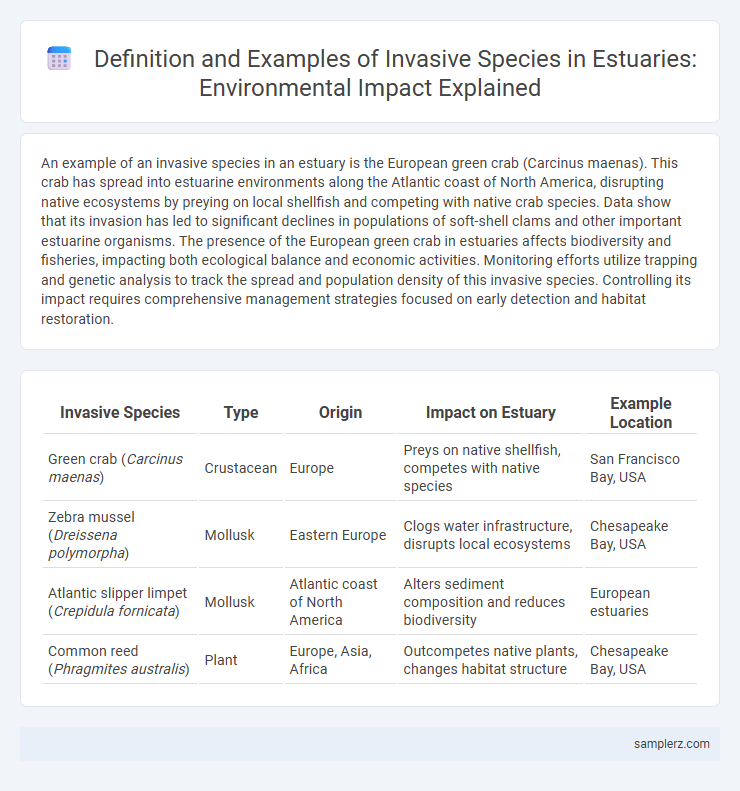An example of an invasive species in an estuary is the European green crab (Carcinus maenas). This crab has spread into estuarine environments along the Atlantic coast of North America, disrupting native ecosystems by preying on local shellfish and competing with native crab species. Data show that its invasion has led to significant declines in populations of soft-shell clams and other important estuarine organisms. The presence of the European green crab in estuaries affects biodiversity and fisheries, impacting both ecological balance and economic activities. Monitoring efforts utilize trapping and genetic analysis to track the spread and population density of this invasive species. Controlling its impact requires comprehensive management strategies focused on early detection and habitat restoration.
Table of Comparison
| Invasive Species | Type | Origin | Impact on Estuary | Example Location |
|---|---|---|---|---|
| Green crab (Carcinus maenas) | Crustacean | Europe | Preys on native shellfish, competes with native species | San Francisco Bay, USA |
| Zebra mussel (Dreissena polymorpha) | Mollusk | Eastern Europe | Clogs water infrastructure, disrupts local ecosystems | Chesapeake Bay, USA |
| Atlantic slipper limpet (Crepidula fornicata) | Mollusk | Atlantic coast of North America | Alters sediment composition and reduces biodiversity | European estuaries |
| Common reed (Phragmites australis) | Plant | Europe, Asia, Africa | Outcompetes native plants, changes habitat structure | Chesapeake Bay, USA |
Introduction to Invasive Species in Estuaries
Invasive species like the European green crab (Carcinus maenas) disrupt estuary ecosystems by preying on native shellfish and competing for food resources. These non-native organisms often arrive through ballast water discharge from ships, establishing populations that alter habitat structure and nutrient cycling. Monitoring and managing invasive species in estuaries is critical to preserving biodiversity and maintaining ecological balance.
Common Invasive Plants in Estuarine Environments
Common invasive plants in estuarine environments include Phragmites australis (common reed), Spartina alterniflora (smooth cordgrass), and Lythrum salicaria (purple loosestrife). These species rapidly colonize mudflats and marshes, outcompeting native flora and altering habitat structure and nutrient cycling. Their proliferation significantly impacts estuarine biodiversity and water quality, leading to disrupted ecosystem functions.
Non-Native Fish Impacting Estuarine Ecosystems
Non-native fish species such as the northern snakehead (Channa argus) significantly disrupt estuarine ecosystems by preying on native fish and competing for resources. Their introduction often leads to reduced biodiversity and altered food web dynamics in estuaries. The ecological imbalance caused by invasive fish threatens the health and sustainability of these critical habitats.
Invasive Crustaceans Altering Estuary Balance
Invasive crustaceans such as the Chinese mitten crab (Eriocheir sinensis) disrupt estuary ecosystems by preying on native species and burrowing into riverbanks, causing erosion and habitat degradation. Their aggressive colonization outcompetes native crustaceans, altering food webs and nutrient cycling within estuarine environments. Monitoring and management efforts are essential to mitigate the ecological impact and preserve biodiversity in affected estuaries.
Effects of Invasive Mollusks in Estuaries
Invasive mollusks such as the zebra mussel (Dreissena polymorpha) and the Asian clam (Corbicula fluminea) disrupt estuary ecosystems by outcompeting native species for food and habitat, leading to reduced biodiversity. These species alter nutrient cycling and water quality by filtering large volumes of water, which can increase water clarity but also deplete plankton populations critical to native fish and bird species. Their dense biofouling on infrastructure like water intake pipes and boat hulls causes economic damage and increases maintenance costs in estuarine regions.
Impacts on Native Biodiversity and Habitats
Invasive species such as the European green crab (Carcinus maenas) disrupt estuary ecosystems by preying on native shellfish and competing with indigenous species for food and habitat. This predation and competition lead to declines in native biodiversity, altering the structure of benthic communities and reducing habitat complexity. The resulting ecological imbalance undermines the resilience of estuarine habitats, threatening essential ecosystem services such as water filtration and nursery grounds for fish.
Pathways of Invasion: How Species Enter Estuaries
Invasive species enter estuaries primarily through ballast water discharge from ships, which transports non-native organisms across oceans. Aquaculture activities introduce foreign species that may escape into natural estuarine habitats, disrupting local ecosystems. Coastal development and recreational boating also facilitate the spread of invasive species by accidental transport on equipment and hull fouling.
Case Studies: Notorious Estuary Invasions Worldwide
The introduction of the invasive European green crab (Carcinus maenas) into the Chesapeake Bay estuary has disrupted native shellfish populations, leading to significant ecological and economic impacts. In the San Francisco Bay, the invasive overbite clam (Potamocorbula amurensis) has altered sediment composition and outcompeted native bivalves, transforming local food webs. The invasion of the comb jelly Mnemiopsis leidyi in the Black Sea estuary caused massive declines in fish stocks by predation on zooplankton and fish larvae, illustrating the profound consequences invasive species can have on estuarine biodiversity and fisheries.
Ecological and Economic Consequences of Invaders
Invasive species such as the European green crab (Carcinus maenas) disrupt estuarine ecosystems by preying on native shellfish and competing for habitat, leading to declines in biodiversity and altered food webs. These ecological disturbances reduce the productivity of commercially valuable fish and shellfish populations, causing significant economic losses for local fisheries and coastal communities. Management costs to control invasions and restore habitats also impose substantial financial burdens on environmental agencies and stakeholders.
Management and Mitigation Strategies for Invasive Species
Effective management of invasive species in estuaries includes early detection through regular monitoring and rapid response protocols to prevent establishment. Physical removal combined with biological control agents helps reduce populations of invasive species such as the European green crab (Carcinus maenas). Habitat restoration and public education programs further support long-term mitigation by enhancing ecosystem resilience and promoting community engagement.

example of invasive in estuary Infographic
 samplerz.com
samplerz.com